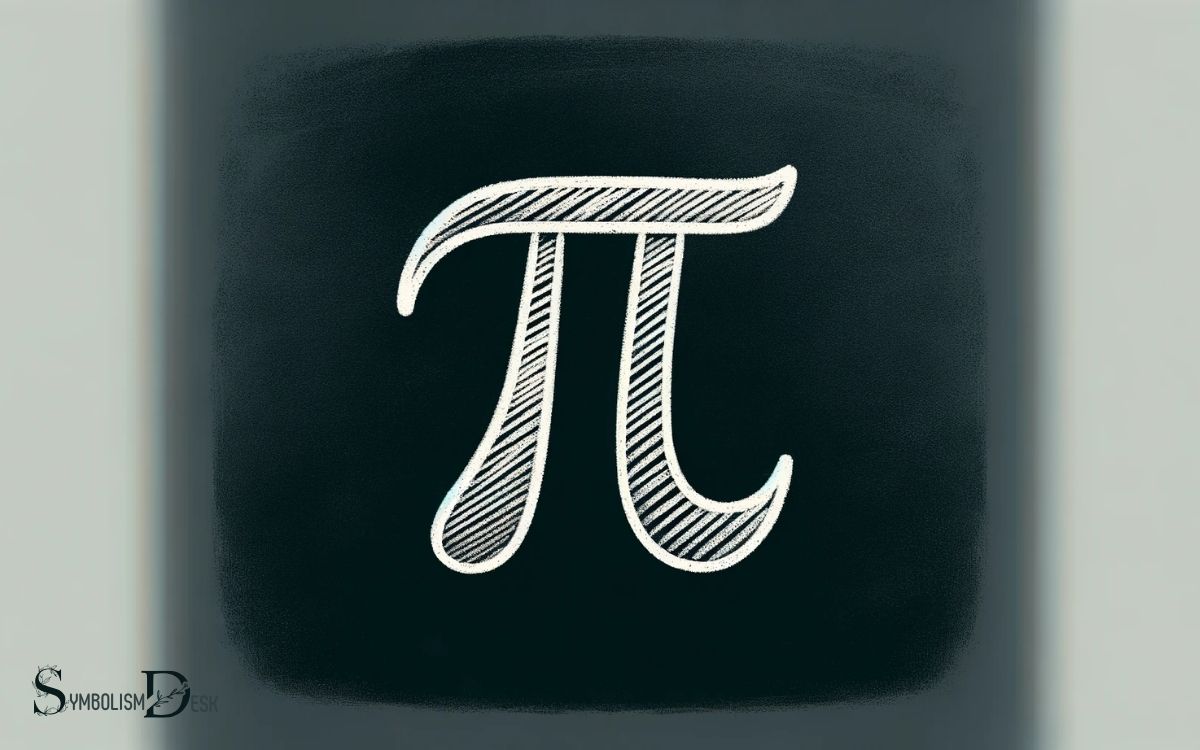What Does the Pi Symbol Mean in Math? Repeats!
The pi symbol (π) in mathematics signifies the constant ratio of the circumference of any circle to its diameter, an irrational number approximately equal to 3.14159. It is crucial in various mathematical disciplines and equations.
Pi (π) is an irrational and transcendental number, meaning it cannot be expressed as a simple fraction and its decimal representation never ends or repeats.
It is integral to the study of circles in geometry, as well as in calculations involving the geometry of waves, circles, and spheres in physics.
Understanding pi is critical in math and science, as it connects circular geometry with physical phenomena.

Key Takeaway
Understanding the Significance of Pi (π) in Mathematics
| Field of Mathematics | Importance of Pi (π) |
|---|---|
| Geometry | Used to calculate the circumference and area of circles |
| Trigonometry | Central to the concept of radians, which measure angles |
| Calculus | Appears in integral calculus for areas and volumes |
| Physics | Essential in formulas for wave dynamics and other phenomena |
The Origin of Pi Symbol
The Pi symbol, denoting the mathematical constant representing the ratio of a circle’s circumference to its diameter, first appeared in mathematical literature in the early 18th century.
It was introduced by the Welsh mathematician William Jones in 1706 and later popularized by the Swiss mathematician Leonhard Euler in 1737.
The symbol “π” is derived from the Greek word “perimetros,” meaning “perimeter.” Initially, it was used as a shorthand to represent this important constant in mathematics. Over time, it became universally recognized and is now an integral part of mathematical notation.
The symbol has since transcended mathematical contexts and has become a widely recognized icon in popular culture, representing not only the mathematical concept of pi but also the broader notions of infinity and the perfection of the circle.
The Significance of Pi
Pi is an indispensable mathematical constant that quantifies the relationship between a circle’s circumference and its diameter. Its significance lies in its universality across all circles, making it a fundamental concept in geometry, trigonometry, and calculus.
Pi allows for the precise calculation of circular properties, such as area and volume, essential in various real-world applications including engineering, architecture, and physics.
Its irrationality, meaning it cannot be expressed as a simple fraction, adds a layer of complexity and mystery, captivating mathematicians and enthusiasts for centuries.
The transcendental nature of pi also means that its decimal representation extends infinitely without repetition, posing an ongoing challenge for mathematicians to calculate and memorize its digits.
Pi’s importance extends beyond pure mathematics, influencing diverse fields and serving as a symbol of the elegance and complexity inherent in the natural world.
Pi in Geometric Formulas
In geometric formulas, pi’s value serves as a crucial factor in determining the properties of circles and spheres. Its presence allows for the accurate calculation of various geometric attributes.
Specifically, pi is used in the following ways:
- Circumference of a Circle: The formula 2πr is used to calculate the circumference of a circle, where r represents the radius.
- Area of a Circle: The formula πr^2 is employed to find the area of a circle, with r denoting the radius.
- Surface Area of a Sphere: The formula 4πr^2 is utilized to determine the surface area of a sphere, where r represents the radius.
- Volume of a Sphere: The formula (4/3)πr^3 is used to calculate the volume of a sphere, with r denoting the radius.
These formulas demonstrate the integral role of pi in geometric calculations, enabling precise determinations of circle and sphere properties.
Pi in Trigonometry
In trigonometry, the concept of pi is commonly encountered in the measurement of angles. Pi is often used in radians, where one complete revolution around a circle is equivalent to 2π radians.
This fundamental relationship between angles and pi is crucial in various trigonometric formulas and calculations, providing a deep connection between the geometry of circles and the study of trigonometric functions.
Pi in Angles
Trigonometry utilizes the constant represented by the symbol π to measure the angles within a circle. In the context of angles, π is crucial in trigonometric functions and the unit circle.
Here’s how π is used in angles:
- Radians: Angles in radians are measured using the unit circle, and π plays a significant role in defining the relationship between the circumference of a circle and its radius.
- Trigonometric Functions: Sine, cosine, and tangent functions, essential in trigonometry, are often expressed in terms of π, especially when dealing with angles.
- Periodicity: The concept of 2π representing one complete revolution around a circle helps in understanding the periodic nature of trigonometric functions.
- Trigonometric Identities: Many trigonometric identities, such as the period of sine and cosine functions being 2π, are defined using π in angle measurements.
Pi in Radians
Pi is utilized in trigonometry to measure angles in radians, demonstrating the relationship between the circumference of a circle and its radius.
In trigonometry, one complete rotation around a circle is equivalent to 2π radians. Radians provide a more natural way to measure angles, especially in calculus and physics, as they directly relate an angle to the arc length it subtends on a circle.
For example, an angle of π/2 radians corresponds to a quarter of the circle’s circumference. This simplifies many trigonometric expressions and equations. It also provides a direct link between trigonometry and the geometry of the circle.
Understanding the concept of radians and their relationship to π is fundamental in advanced mathematics and various scientific fields.
Pi in Formulas
The application of π in trigonometric formulas is essential for understanding the relationships between angles, arc lengths, and the geometry of circles.
In trigonometry, π appears in various formulas and equations, playing a crucial role in calculations and problem-solving.
Here are some key areas where π is used in trigonometric formulas:
- Sine and Cosine Functions: π is fundamental in defining the periodic nature of sine and cosine functions, which are essential in modeling periodic phenomena such as sound waves and alternating currents.
- Arc Length and Sector Area: π is involved in formulas for calculating the arc length and sector area of a circle, providing a direct link between the angle subtended at the center and the corresponding arc and area.
- Trigonometric Identities: Many trigonometric identities, such as the Pythagorean identity and the double-angle formulas, incorporate π, enabling the manipulation and simplification of trigonometric expressions.
- Unit Circle: The unit circle, a fundamental concept in trigonometry, involves π in its definition and plays a crucial role in understanding trigonometric functions and their properties.
Understanding the role of π in these trigonometric formulas is essential for mastering the principles of trigonometry and its applications.
Pi in Calculus
Calculation of areas and volumes involving curves and surfaces often necessitates the utilization of the abstract concept represented by the pi symbol in calculus.
In calculus, pi plays a fundamental role in the formulas used to find the area of a circle, the volume of a sphere, and the surface area of a cylinder or cone.
For instance, when finding the area enclosed by a curve and the x-axis or the volume of a solid of revolution, integrals involving pi frequently arise.
Pi is integrated into calculus not only as a constant but also as a key component in trigonometric functions and complex analysis.
Understanding the significance of pi in calculus is crucial for solving problems related to continuous change, motion, and accumulation, providing a foundational understanding of mathematical principles.
Pi in Physics and Engineering
In calculus, pi’s significance extends into physics and engineering, where its role in fundamental principles and equations is crucial to understanding and solving problems related to continuous change and physical phenomena.
Pi’s influence in physics and engineering is profound, with applications in various areas:
- Circumference and Area: Pi is essential in calculating the circumference and area of circles, which is fundamental in various engineering and physics problems.
- Periodic Phenomena: Pi appears in equations describing periodic phenomena such as waveforms and oscillations, crucial in understanding and designing electrical circuits and mechanical systems.
- Fluid Dynamics: Pi is present in equations governing fluid dynamics, playing a vital role in the design of aircraft, ships, and hydraulic systems.
- Signal Processing: In signal processing, pi is used in Fourier transforms to analyze and process signals in engineering applications such as telecommunications and audio processing.
Fun Facts About Pi
Pi symbolizes an irrational number that represents the ratio of a circle’s circumference to its diameter. Despite being a fundamental constant in mathematics, pi’s digits have been calculated to trillions of decimal places, yet it still exhibits no repeating pattern.
This has led to an annual celebration of Pi Day on March 14th (3/14) around the world. The fascination with pi has inspired competitions where people recite the digits from memory.
Surprisingly, attempts to use legislation to declare a finite value for pi have been made in the past.
Additionally, pi has found its way into pop culture, with references in movies, music, and even a Sky & Telescope article where the magazine humorously suggested that pi should be legally changed to 3.2.
Conclusion
The Pi symbol in math is a significant and widely used mathematical constant representing the ratio of a circle’s circumference to its diameter.
It is used in various mathematical disciplines such as geometry, trigonometry, calculus, physics, and engineering. The symbol has a rich history and plays a crucial role in many mathematical formulas and calculations. For students and professionals alike, understanding the significance of these symbols can greatly enhance problem-solving skills and comprehension of advanced concepts. Resources such as textbooks and online platforms often provide sections where math symbols explained in detail help clarify their meanings and applications in different contexts. This not only fosters a deeper appreciation for the subject but also equips learners with the tools necessary to tackle complex mathematical challenges.






